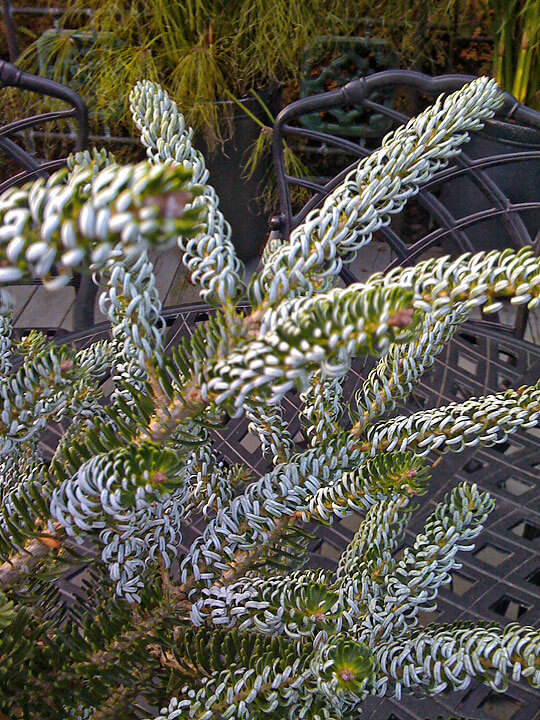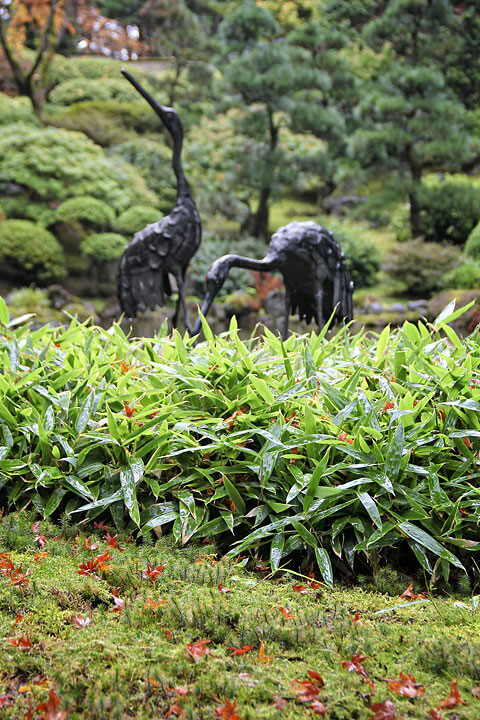Quite often when we think of evergreen plants or use the word ‘conifer’, we think of something large like a Douglas Fir, Colorado Spruce or similar tall tree. It is true, these are evergreen plants and they are conifers, but you can also plant evergreens in the garden or in containers. In recent years many new, smaller growing types have become available and these are ideal for small-space gardens as well as a container plant for a deck or patio.
 Fir Trees
Fir Trees
I have a friend who is very involved in the American Conifer Society and he is forever encouraging me to add more conifers to my garden. He makes a valid statement when he says that they give some winter interest when many other plants have either lost their leaves or been cut back to the ground.
Two small type of conifers that are worth searching for are Abies koreana ‘Horstmann’s Silberlocke’ (Variegated Korean Fir) and Abies pinsapo ‘Aurea’ (Golden Spanish Fir). The ‘Horstmann’s Silberlocke’ just grows about 6-12 inches a year. The feature that makes this such an interesting plant is that the needles slightly curl around the stem and reveal the silver-white undersides. This is an ideal plant for a container and is especially nice in the winter to have by an entryway to a house to enjoy the silver color. Add a red bow and you have a holiday container. The Golden Spanish Fir, is as the name implies, a golden color which stands out against the older blue needles. It is also slow growing and can easily be kept in a container.
Evergreen Bamboo

Of course there are other evergreen plants in the garden that should not be overlooked. Many of the bamboos can give wonderful foliage and color throughout the year. We have a beautiful planting of Phyllostachys aureosulcata ‘Spectabilis’ (Crook Stem Bamboo) in our garden that is a much asked about plant when we have visitors. The stems tend to develop kinks as they grow and this makes for a very interesting pattern. We have taken the lower leaves off of our planting to showcase this ‘kinking’ and also to highlight the green stripes on the yellow culms. This is a running type and it is advisable to use a bamboo barrier to prevent it from spreading or to plant it in a large container.
Not all bamboo is tall and a good example of a low growing type is Sasa veitchii. This bamboo may reach 3-5 feet in height but can be kept as a compact ground cover by trimming it to near ground level each spring. It does best in some shade and might be an ideal plant for a slope or area where some erosion control is needed. One of the unique aspects of this bamboo is that in the fall as the nights get cooler, the leaves wither at the margins and turn into what looks like bright white variegation. Then in the spring, the leaves turn green. It is considered winter hardy to 0⁰ F.
Sweet Olive
Another group of plants that are evergreen is the genus Osmanthus. Many times people mistake these for holly as some of them do have a holly-like leaf. However, what Osmanthus can provide that holly does not is flowers with a fragrance. The Lan Su Chinese Garden (formerly Portland Classical Chinese Garden) in Portland, Oregon has a large specimen of Osmanthus heterophyllus which blooms in winter with creamy white flowers and a strong fragrance that sometimes permeates outside the walls of this garden to passersby walking along the street. Another good garden plant is Osmanthus fragrans (Sweet Olive) which is an evergreen shrub, also with very fragrant flowers that appear in spring and early summer.
 Meyer Lemon
Meyer Lemon
Here in the Pacific Northwest, many gardeners also grow citrus as container plants. While not winter hardy, if you have a greenhouse or sunny room with plenty of light, they should overwinter and be ready to set outside in the spring. The Meyer Lemon tends to be one of the hardier ones and most garden centers will stock plants in the late spring and summer. In my garden I have a variegated leaf form of Meyer Lemon in a container that not only has variegated color in the foliage but on the fruit as well. It tends to bloom throughout the summer with extremely fragrant flowers.
We may be in the middle of winter, but our garden can still supply us with much color, primarily from foliage, twigs, bark or berries. Try some new plants in your garden and as my conifer friend tells me “mix it up”.
As we approach the end of 2012, I would like to extend a very happy 2013 to all. Let’s make it a happy and productive garden year.

